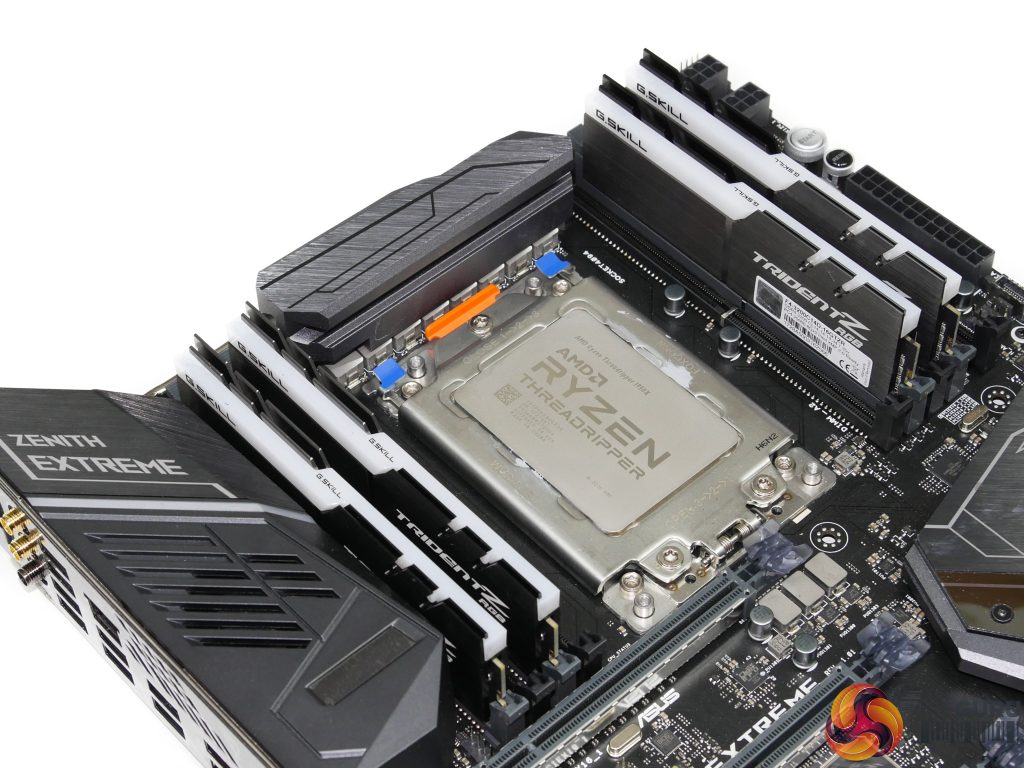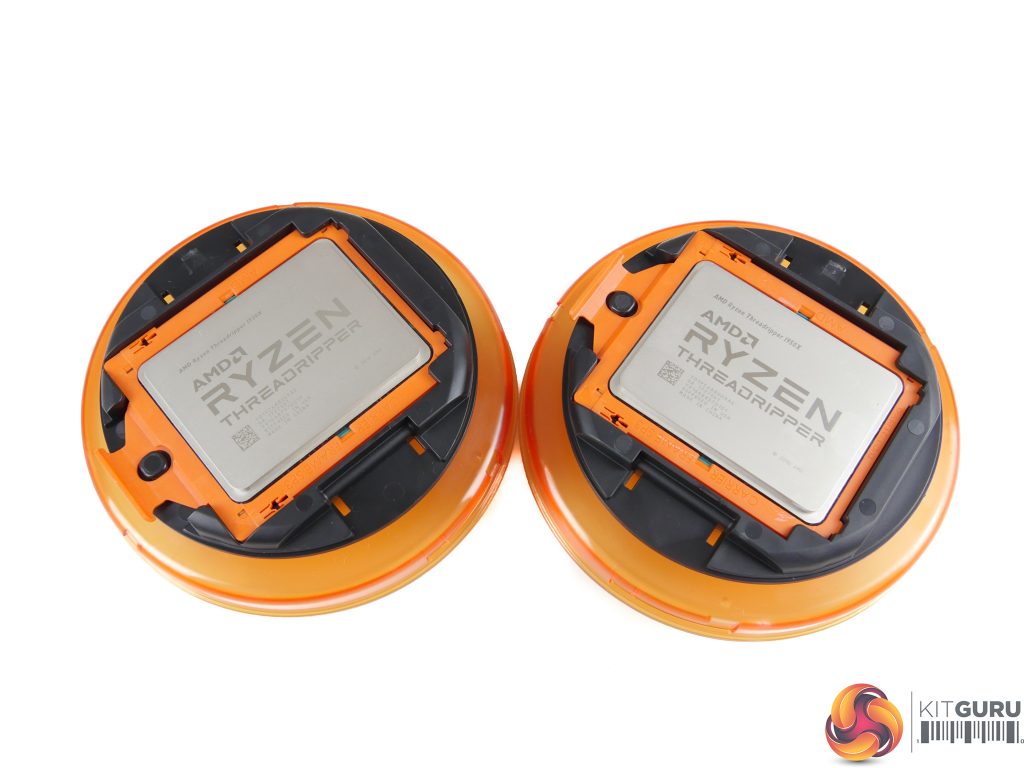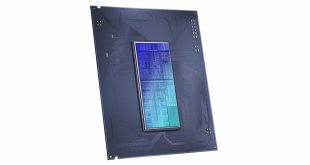AMD’s Ryzen Threadripper processors are unequivocally fast computational powerhouses. For the first time in many, many years, AMD can justifiably claim to offer the highest performance consumer processor on the planet in the 16-core Ryzen Threadripper 1950X. And in many cases, the chip vendor can also claim to offer the second-highest performance consumer processor on the planet in the 12-core Ryzen Threadripper 1920X.
Such statements would have been unthinkable less than a year ago. Even today, many people will still be in shock that AMD – who barely had a foot in the mainstream market six months ago, not to mention the HEDT segment – has dethroned Intel as the company offering the highest performance consumer processor available. Usually there’s an asterisk to accompany such a statement but in this case, that asterisk only extends to gaming scenarios or lightly-threaded tasks. Anything that is heavily multi-threading in nature is highly likely to show AMD’s Ryzen Threadripper 1950X as the fastest consumer CPU on the planet.
As already highlighted, multi-threaded performance from both Ryzen Threadripper processors is highly impressive. The 16-core 1950X had so much computational power that our high bit rate 4K conversion using Handbrake could only push the 32 threads to around 80% utilisation. That leaves enough performance spare for the system to still be used for other relatively demanding tasks such as photo editing. File archival and decompressing performance hit new heights, as did multi-threaded rendering results in Cinebench R15.
There are some instances where clock speed advantages for Intel’s Core i9-7900X still prove useful, such as some 1080p x265 encoding tasks. Single-threaded performance from Ryzen Threadripper is solid and is competitive against Broadwell-E. But compared to Skylake-X with its higher IPC and faster clocks, the Skylake-based chips are better in single- or lightly-threaded tasks.
Gaming performance certainly isn’t the domain of a 12- or 16-core CPU. Ryzen Threadripper offers comparable gaming performance to Ryzen 7 thanks to its similar clock speeds. However, Intel’s Core i7 Kaby Lake and Core i9 Skylake-X CPUs are generally higher-performance gaming options. These differences are only realistically noticeable past 60 FPS, so with the resolution increased to a point where the GPU is the limiting factor in going past 60 FPS, Ryzen Threadripper is perfectly capable.
What Threadripper does offer gamers, however, is significant spare CPU resources that can be used for streaming or transcoding or other multi-tasking whilst gaming. For example, Ghost Recon Wildlands rarely used more than 25% of the 1950X’s CPU horsepower. That leaves plenty of resources available to high bit-rate streaming and transcoding in real-time.
Power draw is extremely high from both the 12-core 1920X and 16-core 1950X. Even compared to Intel’s hungry Core i9-7900X, the Ryzen Threadripper chips demand a substantial amount of electricity. You will push past 300W system-wide usage from the wall when either chip is loaded with Cinebench. Overclocking using 1.4V will push the 16-core well past 500W with the 12-core going deep into the 400W range. With that said, performance per Watt for the Ryzen Threadripper CPUs (as measured using Cinebench R15) is quite impressive. I thought a 760W Seasonic PSU would be enough for any CPU I put in my processor test system alongside a single GTX 1080 Ti. Ryzen Threadripper 1950X has made me re-think my decision.
Ryzen Threadripper temperatures are very impressive when taking performance into consideration. Using a 360mm Asetek AIO cooler, we rarely saw either CPU pushing past 80°C when overclocked (though they were close). AMD is clearly rewarding users for investing in high-performance cooling solutions as the soldered heatspreader does a stellar job at transferring thermal energy away from the CPU dies. Intel’s Core i9-7900X uses over 100W less power than the 1950X when overclocked but still runs hotter (even accounting for differences in the AIO coolers used). If you plan to push past 1.4V when overclocking or simply want better temperatures, custom liquid cooling is advisable. AMD’s effective thermal packaging for Ryzen Threadripper should allow custom water-cooling to be used to its full potential.
AMD’s X399 HEDT platform approach is noticeably different to the approach that Intel has taken with its X299 HEDT platform. Instead of locking certain features to certain CPUs, AMD has chosen to give all Ryzen Threadripper chips the full whack of 64 PCIe 3.0 lanes (60 usable) and quad-channel memory support. AMD tends to leverage from-CPU connectivity for devices such as PCIe SSDs and USB whereas Intel prefers the from-chipset approach afforded by its feature-rich X299 PCH. One clear advantage for Intel is its ability to offer PCIe NVMe SSD RAID through the 200-series chipset or after (begrudgingly) purchasing the VROC key and using CPU lanes. On the other hand, the sheer capacity for PCIe expansion using 60 CPU-based PCIe 3.0 lanes is a clear benefit for AMD. Is 60 lanes from AMD too many for most people? Probably. Is 44 lanes from Intel enough for everybody? Unlikely.
The AMD Ryzen Threadripper 1950X will be available for $999 USD MSRP (currently just under £1000 on Overclockers UK). The AMD Ryzen Threadripper 1920X will be available for $799 USD MSRP (currently £799.99 on Overclockers UK).
With Ryzen Threadripper, AMD has done the unthinkable and stolen the HEDT performance crown from Intel. There are scenarios where Threadripper doesn’t do as well as Skylake-X but they are limited primarily to high refresh rate gaming. For computationally-intensive tasks that demand plenty of threads, AMD’s Ryzen Threadripper CPUs are currently the best options on the market.
It doesn’t look like that will change until the end of September at the earliest. And depending on the clock speeds that Intel’s 18-core i9-7980XE actually hits, AMD’s Ryzen Threadripper 1950X may be in a strong position to maintain its place on the HEDT processor throne. Either way, the all-out performance and performance against cost for AMD’s Ryzen Threadripper 1950X and 1920X processors is absolutely superb.
Discuss on our Facebook page HERE.
Pros:
- Superb multi-threaded performance.
- 1950X is the highest-performance consumer CPU available and the 1920X is generally second-fastest.
- Excellent price versus performance even compared to Ryzen 7.
- Quad-channel memory support with high bandwidth results and high-capacity ECC compatibility.
- Performance-per-Watt based on Cinebench is very good for the 1950X and good for the 1920X.
- Good thermal performance given the power draw thanks to the well-designed, soldered heatspreader.
- Plenty of PCIe 3.0 connectivity from the CPU’s 60+4 lane counts.
- X399 looks to be a well-built platform with a good feature set.
Cons:
- Power draw is very high, albeit sometimes justifiable on a performance per Watt metric.
- Strong overclocking for high-core count CPUs but Intel’s 10-core i9-7900X at 4.6GHz remains a solid competitor.
- Intel’s Skylake-X i9-7900X is generally faster in frequency-driven or less heavily-threaded tasks.
KitGuru says: Offering superb multi-threaded performance while maintaining solid overclocking capacity and manageable thermals, AMD’s Ryzen Threadripper processors have taken the fight to Intel’s Skylake-X line-up and the 1950X has stolen the HEDT performance crown in the process. Factoring in AMD’s aggressive pricing, we are left exceedingly impressed by AMD’s Ryzen Threadripper. Highly recommended.
 KitGuru KitGuru.net – Tech News | Hardware News | Hardware Reviews | IOS | Mobile | Gaming | Graphics Cards
KitGuru KitGuru.net – Tech News | Hardware News | Hardware Reviews | IOS | Mobile | Gaming | Graphics Cards







So it’s a beast for productivity [if it’s capable of delivering reliability in the long run], and it’s just fine for gaming, but not as cool as Intel. Not bad, not that great either. No reason to go away from X299 for now. I wonder how will the 12 – 18core Intel fare, both with performance and prices. Great review, proving my point in many discussions, thank You 🙂
so single core comparation is done with intel set at 4.5-5GHz and AMDs at 4.0GHz, and you’re surprised of that Intel’s is better 😐
So to test the maximum overclocked speeds of each you want Luke to achieve a 4.5ghz overclock on the Ryzen even though its just not possible. Perhaps Gandalf can help him with some magical powers.
Yes. All testing is done at stock and the realistic achievable overclocks on each CPU. Throttling Intel back to X GHz would be unfair if the Intel chips can OC further. Just as it would be unfair to throttle back Ryzen CPUs if they have faster clock speeds than their competitors.
Stock and realistic OC frequency is what we always test on all CPUs. Intel’s Skylake-X and Kaby Lake CPUs tend to OC higher than AMD’s Ryzen chips so that’s what people run their frequencies at and that’s what we test with.
Luke
Ok, i get that but …
1. Same cooling was used for both?
2. Is TR restricted, or why can’t it go pass the boosted clocks?
So, considering that AMD again gives 50 and 60 percent more cores for a same or the similar price those CPUs are a beasts for people who need productivity and content creation CPU
Who games at 1080p with a £1000 CPU and a GTX1080 ti? Wasn’t Ryzen equal to its intel equivalent at higher resolutions, Is this the same with ThreadRipper?
“Cons” in the review are so depraved you can not even imagine, and lacking 1 star out of 10…. For what? For not being available for free?
Oxymorons
I have to slightly disagree with the gaming analysis. Many times the reason RYZEN doesn’t perform well in gaming is that game developers still haven’t had enough time to optimize the RYZEN platform. Game developers haven’t had enough time with the AMD RYZEN hardware development kits as of yet.
The same cooling was used for all CPUs (280mm AIO) except Threadripper which used a 360mm Asetek AIO due to mounting compatibility.
The frequency limits for Ryzen look to be related to the manufacturing process technology used by AMD. At its own fabs, Intel looks to have the ability to manufacture dies that can operate at a higher frequency in general.
1080P and a fast GPU helps isolate CPU performance by ensuring no resolution- or GPU-induced bottlenecks are introduced. Our 4K testing shows Ryzen to be far more competitive against Intel when the performance onus is planted more firmly on the GPU.
Ok, thank you. Maybe Threadripper will be able to get higher OCs with some bios updates, how it happened to Ryzen 🙂
Are you confident its not a fabric/zeppelin die limitation rather than the zen core or the ccx?
If that hasnt been eliminated, perhaps raven ridge can shed some light eventually? As i understand it, and given it must be low power for mobile, it will be a single 4 core zen ccx & a single vega gpu on a die like ryzens zeppelin die. Point being, maybe it can clock better in that die form.
Agreed. Irrespective of the amount cooling available, no multi cores CPU would survive a Prime95 stress test on all cores for 30 minutes, let alone 1 hour or more. Prime95 should be taken off the web.
Current rumors predict $1,700 for the 16-core, and $2,000 for the 18-core.
Hey Luke. May I ask how you obtained the all-core turbo frequencies of the 1920X and 1950X? And how confident are you that they are correct? I ask, only because other sources have consistently stated 3.60 GHz for the 1950X. Thank you very much for this in-depth review.
Those are not rumors, they are official Intel pricing, confirmed by multiple outlets and reviewers.
18 core Intel i9 will be $1999.99 (USD)
16 Core Intel i9 will be $1799.99 (USD)
Price v Performance is going AMD’s route, they will end up taking a good portion of the HEDT market with their aggressive pricing and their performance.
“But muh i9 is faster”..
It also has less PCI-E lanes, uses more energy, when overlocked Intel’s 10 core gets hotter than the 16 core AMD, and dollar per dollar is less of a value. This again has been confirmed in testing via many respected hardware outlets/reviewers.
I only have 12 years as an IT professional in hardware management systems, what would I know.
They got the 16 core 1950X to 5.2Ghz on LN2 (Liquid Nitrogen), while that was obviously not representative of real world operations, it did show what can be done.
The issue Intel faces is the technology change that is currently happening where we are switching software from single core/thread ops to multicore and having code recognize the maximum amount of cores possible.
How is this a problem for Intel?
Despite having an immense about of capital to work with an state-of-the-art R&D facilities, Intel’s latest chips have issues with overclocking all cores and remaining efficient. In fact if you look at Intel’s turbo boosts they downclock heavily after 4 cores to keep TDP and energy consumption manageable and competitive. Intel’s biggest weakness is their ability to maximize silicon yields, this is one of the reasons they charge so much for their CPU’s, while AMD’s current approach allows them to scale as they need to with less transistors required on a single die, maximizing yield.
At this current rate I fully expect AMD to release their Zen 2 7nm CPU before Intel gets Cannon Lake (10nm) CPU’s out as AMD is already reporting over 80% yields with 14nm silicon, and anything above 60% yield allows for very competitive prices.
Okay, thanks John. And for the record, yes, I am fully supportive of Threadripper. Intel has been screwing people over for too long.
I’m not sure why you decided to say this, however.
Intel chips are NOT cool. Not even the 91w i5’s. Unless if you think 80c on watercooling for a STOCK i5 Skylake is cool.
Threadripper better as $1k for 16 cores 32 threads when intel like $2k for that. Ya had enough of limitations and greed
Why was enermax aio not used?
I agree. The 16-core 1950X was available on Amazon for $800 not too long ago.
Not as “cool”?, in what sense exactly? as in an over priced haircut kinda cool?
ur obviously a fanboy dick swinger, the only diff. this time u aint playing with the biggest dick.
All reviews out there on the net show Threadripper is faster in basically all productivity apps other than some outdated software that runs better on quads, TR uses less power, has better SMT, has more IO, costs less and has excellent motherboard support.
Wake up from ur delusional dream Bub, just ’cause ur sore that u overpaid for an overvolted stove top cpu that don’t do shit, don’t mean u have to spread ur bull shit propaganda.
Love the 1950x. Runs well at 4.1GHz, and running Prime95 simultaneously w/CPU-Z stress (all cores at 100%), T 105 fps. Other benchmarks show very good performance and durability.